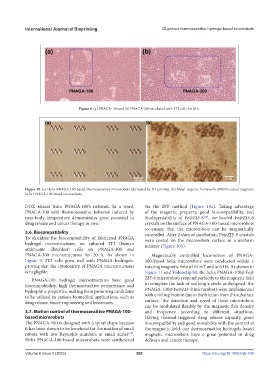Page 288 - IJB-9-3
P. 288
International Journal of Bioprinting 3D-printed thermosensitive hydrogel based microrobots
Figure 9. (a) PNAGA-100 and (b) PNAGA-300 incubated with 3T3 cells for 20 h.
Figure 10. (a) Helix PNAGA-100-based thermosensitive microrobots fabricated by 3D printing. (b) Metal–organic framework (MOF)-coated magnetic
helix PNAGA-100-based microrobots.
DOX release from PNAGA-100’s network. In a word, via the 2PP method (Figure 10a). Taking advantage
PNAGA-100 with thermosensitive behavior induced by of the magnetic property, good biocompatibility, and
near-body temperature demonstrates great potential in biodegradability of Fe@ZIF-8 , we loaded Fe@ZIF-8
[38]
drug release and cancer therapy in vivo. crystals on the surface of PNAGA-100-based microrobots
to ensure that the microrobots can be magnetically
3.6. Biocompatibility controlled. After 2 days of incubation, Fe@ZIF-8 crystals
To elucidate the biocompatibility of fabricated PNAGA were coated on the microrobots surface in a uniform
hydrogel microstructures, we cultured 3T3 (human manner (Figure 10b).
embryonic fibroblast) cells on PNAGA-100 and
PNAGA-300 microstructures for 20 h. As shown in Magnetically controlled locomotion of PNAGA-
Figure 9, 3T3 cells grow well with PNAGA hydrogels, 100-based helix microrobots were conducted within a
proving that the cytotoxicity of PNAGA microstructures rotating magnetic field of 15 mT and at 6 Hz. As shown in
is negligible. Figure 11 and Videoclip S1, the helix PNAGA-100@ Fe@
PNAGA-100 hydrogel microstructures have good ZIF-8 microrobots respond perfectly to the magnetic field
biocompatibility, high thermosensitive performance and to complete the task of walking a circle as designed. the
hydrophilic properties, making them promising candidates PNAGA-100@ Fe@ZIF-8 microrobots were implemented
to be utilized in various biomedical applications, such as with a rolling motion due to the friction from the substrate
drug release, tissue engineering and biosensors. surface. The direction and speed of these microrobots
can be modulated flexibly by the magnetic flux density
3.7. Motion control of thermosensitive PNAGA-100- and frequency according to different situations.
based microrobots Having thermal-triggered drug release capacity, good
The PNAGA-100 is designed with a spiral shape because biocompatibility and good movability with the control of
it has been shown to be beneficial for the motion of small the magnetic field, our thermosensitive hydrogels-based
robots with low Reynolds numbers at small scales . magnetic microrobots have a great potential in drug
[45]
Helix PNAGA-100-based microrobots were synthesized delivery and cancer therapy.
Volume 9 Issue 3 (2023) 280 https://doi.org/10.18063/ijb.709

